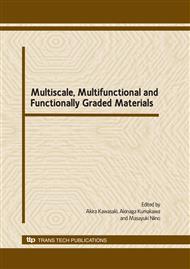p.461
p.465
p.471
p.477
p.483
p.489
p.495
p.501
p.507
Crossover from Metallic to Semiconducting in Pb2-xLnxRu2O7-δ (Ln = Eu, Sm) Compounds with Pyrochlore Structure
Abstract:
We study the synthesis and physical properties of Pb2-xLnxRu2O7- (Ln = Sm, Eu) compounds with pyrochlore structure. The lead-lanthanoid pyrochlores Pb2-xLnxRu2O7- (Ln = Sm, Eu) have been successfully synthesized by the solid-state reaction. All samples were characterized by X-ray diffraction, magnetic susceptibility, and electrical resistivity measurements. Magnetic susceptibility measurements showed that the spin-glass transition temperature, TSG, decreases with Ln content x and goes to zero at x = 0.2 and 0.6 for Sm and Eu, respectively. From electric resistivity measurements, a crossover from metallic to semiconducting behavior was observed in the range of 0.2 ≤ x ≤ 0.4 and 0.4 ≤ x ≤ 0.8 in Pb2-xSmxRu2O7- and Pb2-xEuxRu2O7-, respectively. These boundaries between metallic and insulating phases mostly correspond to values of x with TSG = 0. These metal-insulator transitions can be caused by the strongly correlated couplings between the itinerant 4d electrons which are possibly attributed to the magnetic frustration.
Info:
Periodical:
Pages:
483-488
Citation:
Online since:
October 2009
Authors:
Price:
Сopyright:
© 2010 Trans Tech Publications Ltd. All Rights Reserved
Share:
Citation:


